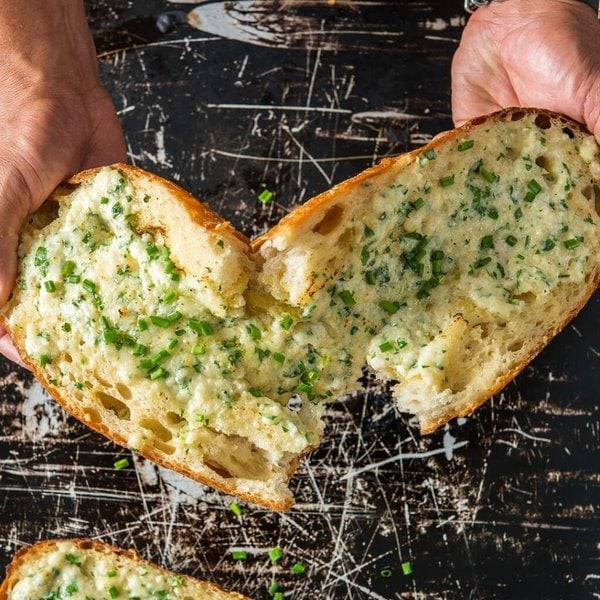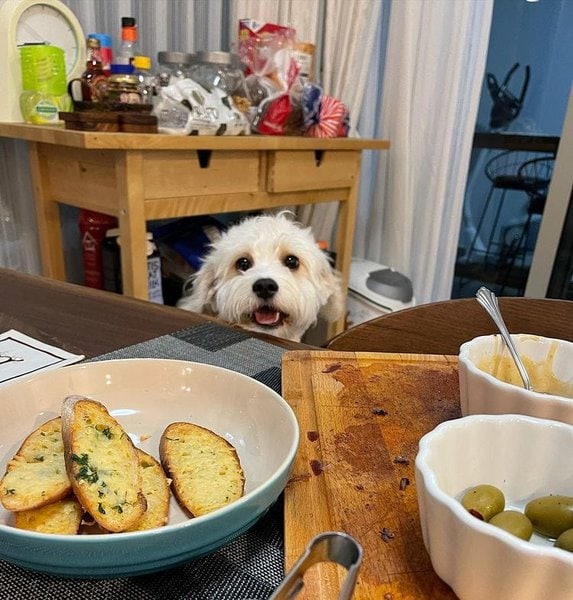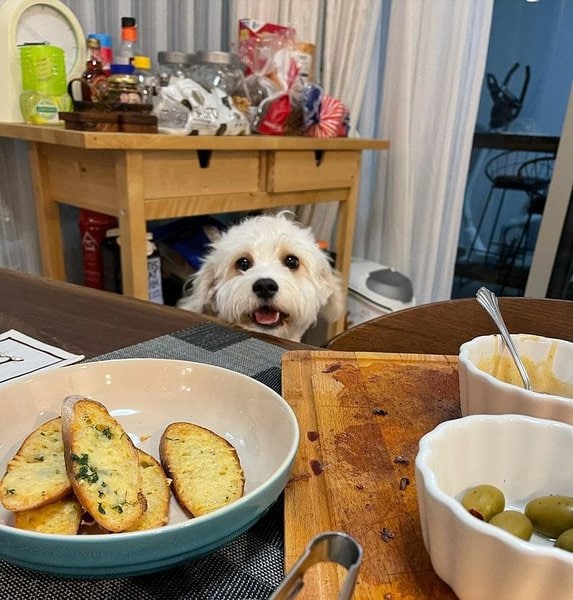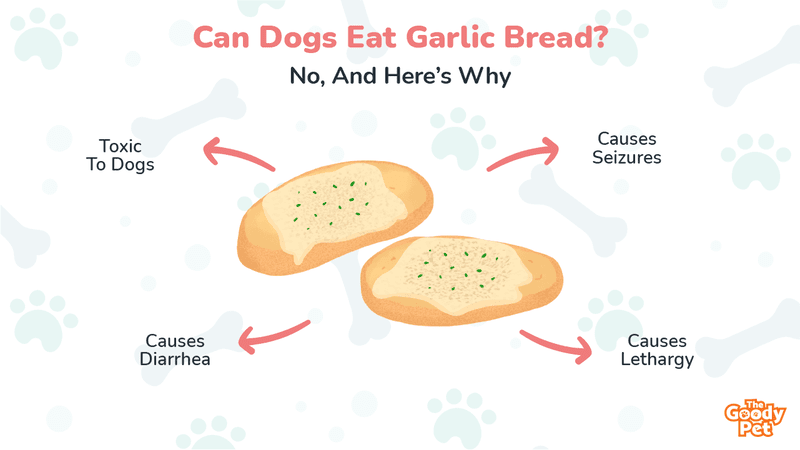Garlic bread is a great accompaniment to pasta, soups, or stews. The simple combination of bread, butter, or olive oil, and garlic with its crunchy texture and savory taste makes our mouth water especially when we add Parmesan or shredded mozzarella in it. But is it safe to share it with our furry best friend?
No, it is not safe for dogs to eat garlic bread. Garlic is one of the most toxic foods that you must avoid giving to your pet dog. Together with onions and chives, which belong to the Allium family of plants, it contains the chemical thiosulfate that is known to cause oxidative damage to red blood cells.
Although bread and olive oil are relatively safe for dog consumption, garlic is the main culprit why we should refrain from giving garlic bread to our dogs.
In this article, we will discuss in detail the effects of garlic, whether in its raw form or powdered, on the health of your beloved pooch, as well as the amount of garlic our dogs can tolerate.
What Happens If My Dog Eats Garlic?

The amount of garlic in the bread your dog consumed will determine the reaction to its health. The size and breed of your dog also determine the effects, particularly Japanese dog breeds like Akita and Shiba Inu, which for some reason are very sensitive to garlic.
Garlic consumption has a cumulative effect, and it can build up in your dog’s system over time. It contains the chemical compound thiosulfate.
While human enzymes can digest this compound, dogs cannot. Thiosulfate acts by rupturing the red blood cells, called hemolysis, and destroys the hemoglobin, which is responsible for transporting oxygen from the lungs to other parts of the body.
Lack of oxygen in the blood, or hemolytic anemia, would speed up heart rate and cause your dog to tire easily and lose breath becoming weak and lethargic. This would also cause the gums and inner eyelids to turn pale.
Other compounds found in garlic can also relax the heart muscles and dilate the blood vessels reducing blood pressure. This increases the heart rate further making it difficult for blood to be pumped.
Signs Of Garlic Toxicity In Dogs
The following symptoms may take a while to show their effect, and some would even take days to appear. If you suspect that your dog has ingested large amounts of garlic, it is better to take it to the veterinarian immediately.
- Vomiting
- Diarrhea
- Drooling
- Lethargy
- Panting and restlessness
- Abdominal pain
- Weakness
- Loss of coordination
- Pale gums
- Seizures
How Much Garlic Bread Can Kill A Dog?
For the most part, a small slice of garlic bread would not probably harm your dog and only cause minor discomfort like a gassy stomach.
Since most commercially available garlic bread only uses a sparse amount of garlic, it is nothing to lose sleep over especially if your dog ate it only once.
If, however, your pooch accidentally ate the whole loaf of bread or has been consuming small amounts of garlic bread regularly, then you should look for warning signs of garlic toxicity or poisoning.
Researchers have calculated that approximately 1.5 to 3 teaspoons of raw garlic per pound of a dog’s body weight are what it takes to produce harmful effects on your dog. The same amount is also applicable to garlic powder.
In simpler terms, a 20-pounder dog would need to ingest around 50 cloves of garlic to be toxic. That is a large amount but remember that garlic’s effect is cumulative. Ingesting small amounts regularly would have negative impacts in the long run.
Are The Other Ingredients Of Garlic Bread OK For My Dog?

Aside from garlic, garlic bread is also smothered in butter or olive oil, parsley, salt, and in some cases certain cheeses. Garlic powder is also used in some instances as an alternative to raw or fresh garlic.
Olive Oil
This oil has a lot of benefits to your furry pet. It is a great source of monounsaturated fats, essential fatty acids, and antioxidants.
It promotes a healthy coat and keeps skin supple and healthy. It also boosts immunity against diseases and improves digestive health.
Butter
Butter’s high-fat content can present some health risks to your dog including heart disease and obesity. It is also not recommended for dogs suffering from lactose intolerance.
Salt
Too much salt is bad for your dogs and can make them overly thirsty. It can also cause vomiting, diarrhea, and tremors.
Garlic Powder
The effects of garlic powder are the same as fresh garlic and should be avoided. In some cases, garlic powder can be more potent than the raw variety depending on the manufacturer.
Parsley
The curly-haired variety of parsley is the one recommended by animal nutritionists rather than the spring variety which can be toxic. In moderate amounts, it is a good source of vitamins A, C, and K and helps improve immunity.
Cheeses
Some garlic bread is topped with grated Parmesan, mozzarella, cheddar, or feta. These are all high in fat and salt content and should not be a regular part of their diet.
Obesity and possible pancreatic problems could arise if not given moderately.
Bread
Of course, we could not talk about garlic bread without including the vehicle where everything is put together, and that is the bread.
Bread is full of carbohydrates and should not be part of a dog’s regular diet. It can cause obesity if given regularly and it does not have enough nutritional benefits to our furry best friend.
What To Do If My Dog Ate Garlic Bread?
Small portions of garlic bread may not produce many negative effects but to make sure that your pet is safe, you can do the following steps.
Observe
Look for signs of any discomfort from your dogs, such as vomiting or diarrhea. Small amounts of garlic can cause a reaction from some sensitive dogs.

Secure
Check and secure your area if there are any pieces of garlic bread or other food with garlic lying around. Keep it out of your pet’s reach by storing it in containers or placing it inside the cupboards.
Know
It is best to learn how much garlic bread your dog has eaten, how much garlic is in the bread, and when did it consume it.
This would let you know the severity of the situation and also make it easier for the veterinarian to treat your dog.
Call
Having assessed the situation, you can now call or visit your veterinarian if the condition of your dog does not improve.
Your veterinarian would administer some tests and provide treatments that would decrease the effects of garlic in the blood.
How Is Garlic Poisoning Treated?
Your veterinarian would probably take blood samples from your dog to know its complete blood count and check for anemia.
They may also try to induce vomiting to lessen the impact of garlic on your dog’s system. Activated charcoal may also be administered to prevent the toxin from being absorbed by the digestive system.
If the toxin had been absorbed into the bloodstream causing vital oxygen to be depleted, the veterinarian may administer IV fluids to keep it hydrated, and drugs, including iron, for oxygen therapy.
For severe patients, a blood transfusion might be required. The prescription of immunosuppressive medications, like steroids, might be given which would last from several weeks to months.
The prognosis is usually good, and recovery is full of garlic ingestion is detected early and stopped.
Garlic toxicity is rarely fatal in dogs, but prompt treatment is critical in making sure your dog is safe from the harmful effects of garlic.






